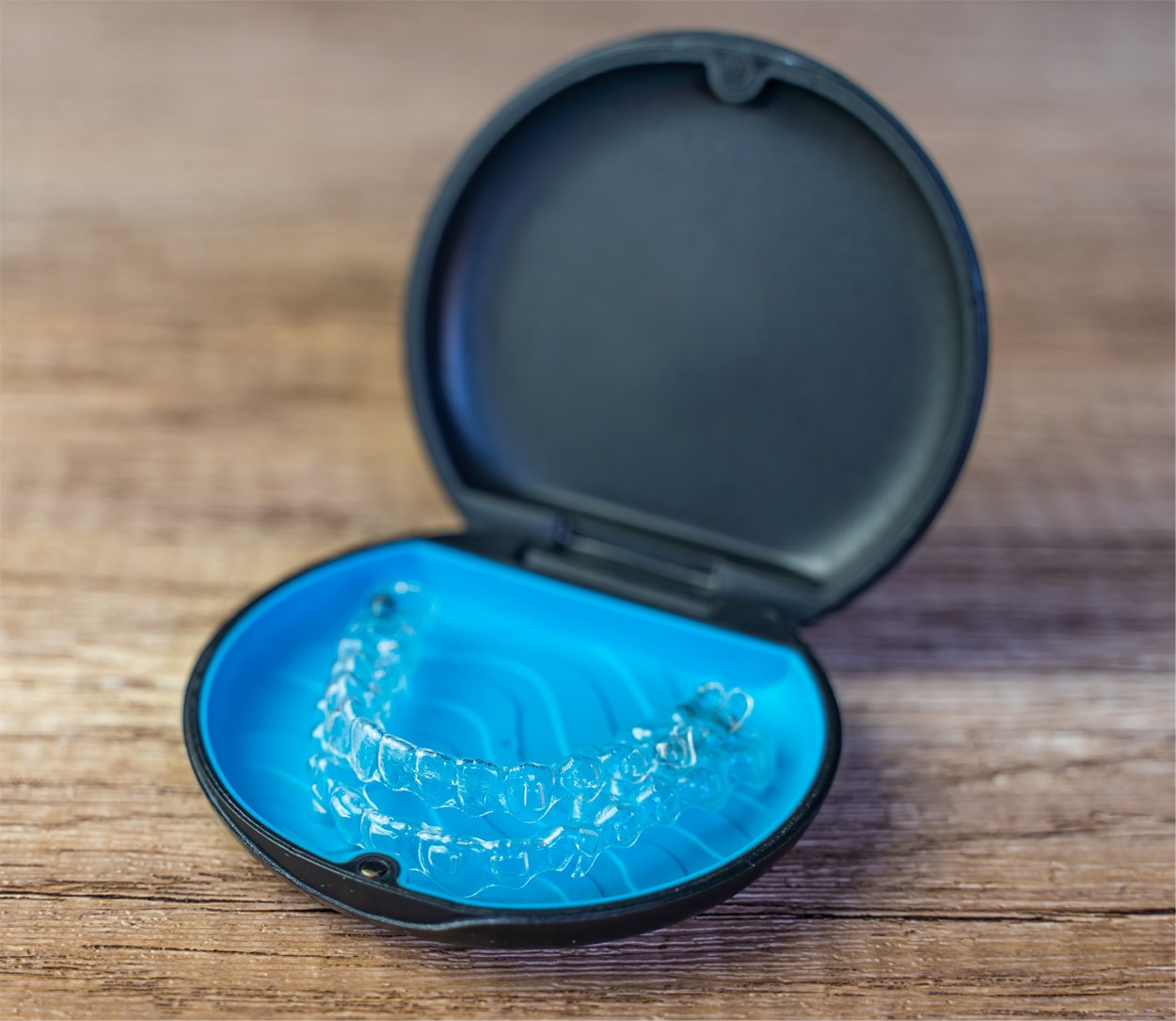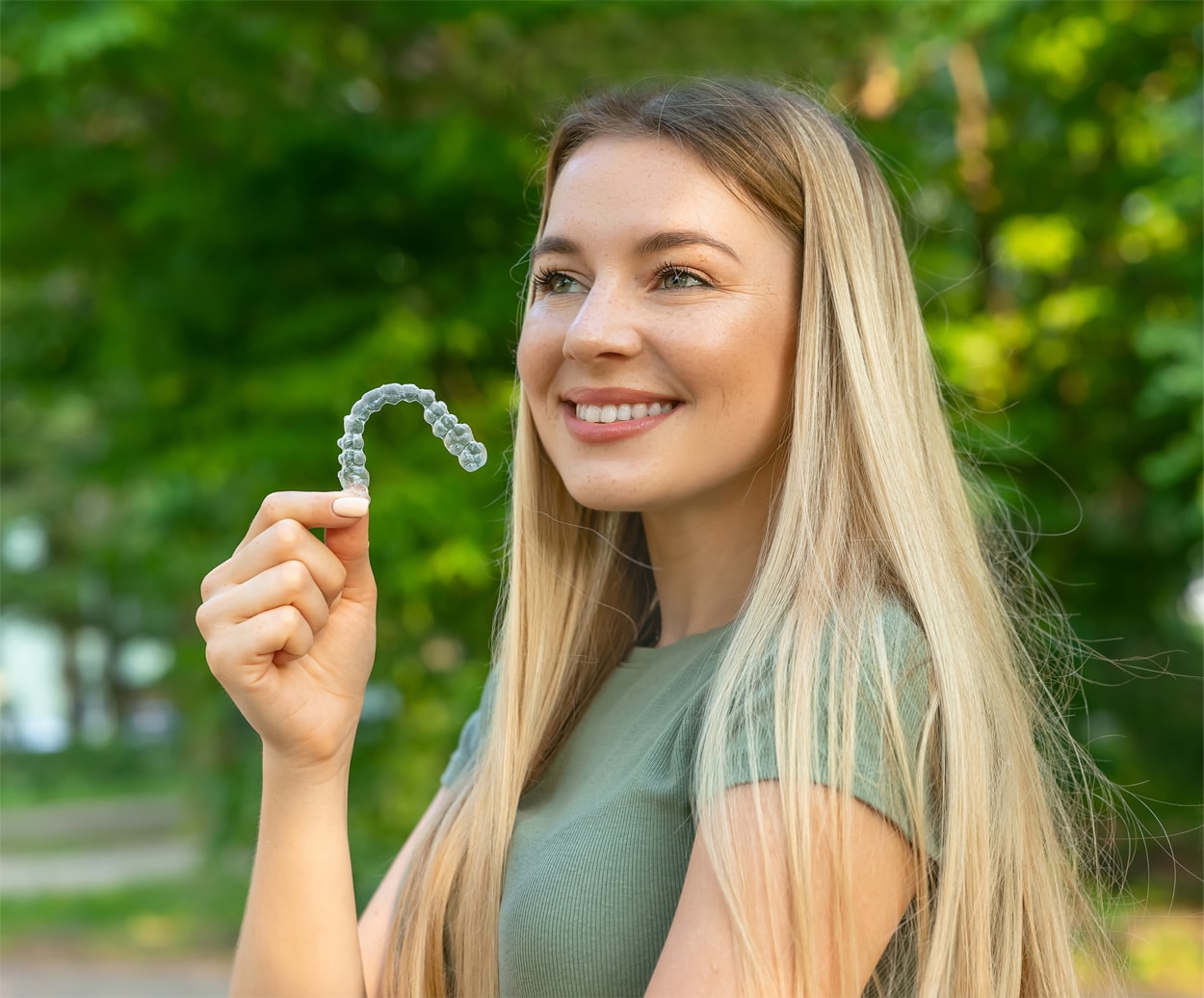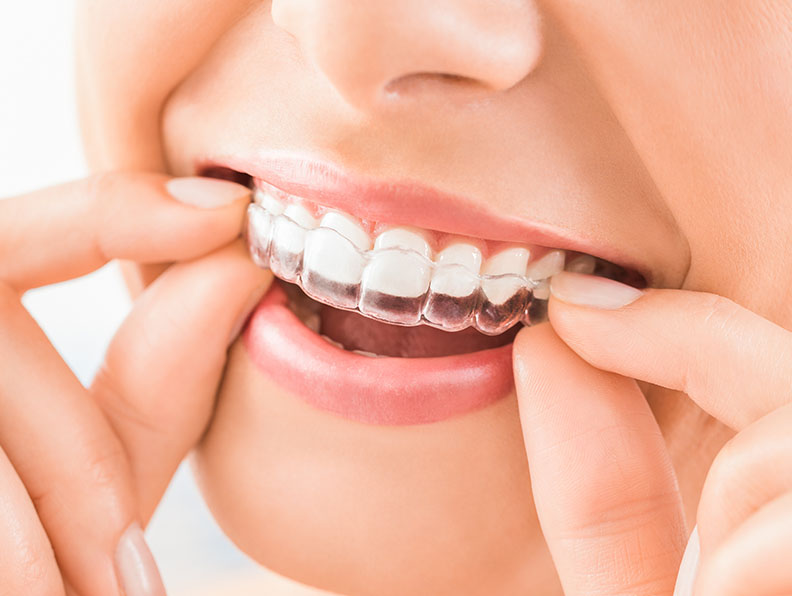Invisalign®
Quick Facts About Invisalign®
- Principle Benefits: Straighter, better aligned teeth; correction of bite issues; and a comfortable and discreet treatment process.
- Candidates: Patients with mild to moderately crooked or crowded teeth, spaces or gaps between teeth, and/or an overbite, underbite, or crossbite.
- Treatment Timeline: On average, treatment may take 9–12 months when patients can commit to wearing aligners for at least 22 hours per day.
- Care: Aligners should be removed and gently brushed with lukewarm water, and natural teeth should be brushed and flossed as normal.
- Cost: The cost of treatment varies per patient; insurance and financing options may be available.
What Is Invisalign®?
 Invisalign is an orthodontic treatment for straightening crooked, unevenly spaced, or misaligned teeth and correcting bite issues. Using a system of clear plastic aligners, the teeth are gently guided into place over time by periodically transitioning through a series of custom-made aligners. These aligners are completely removable, allowing Invisalign patients to eat whatever they like and easily clean their teeth. With Invisalign, our Ridgeland dentist, Dr. Kalil Abide, can straighten your teeth to create the beautiful smile you have always wanted.
Invisalign is an orthodontic treatment for straightening crooked, unevenly spaced, or misaligned teeth and correcting bite issues. Using a system of clear plastic aligners, the teeth are gently guided into place over time by periodically transitioning through a series of custom-made aligners. These aligners are completely removable, allowing Invisalign patients to eat whatever they like and easily clean their teeth. With Invisalign, our Ridgeland dentist, Dr. Kalil Abide, can straighten your teeth to create the beautiful smile you have always wanted.

What Are the Benefits of Invisalign?
The innovative design and orthodontic process of Invisalign can offer numerous benefits to adults and teens with mild to moderate teeth misalignment and bite concerns, including:
- A comfortable way to achieve a more unified smile
- Clear, flexible aligners that are virtually invisible
- No sharp wires or rough metal brackets like traditional braces
- Custom-made aligners to uniquely fit your mouth
- Removable aligners for eating, drinking, brushing, and flossing
- Fewer visits to the dentist for treatment adjustments
During an initial consultation, Dr. Abide will discuss your orthodontic concerns and goals with you to determine a treatment plan that will be the most advantageous for your needs.
Invisalign VS. Braces
While traditional braces can effectively straighten the teeth, there are many inconveniences associated with metal braces. For instance, people are often embarrassed by the appearance of metal braces or experience discomfort from poking metal wires. Invisalign uses clear plastic aligners instead, which are barely visible to others. Braces can also make cleaning the teeth very difficult. Even with diligent maintenance, food can easily become stuck in the braces. Over time, the teeth may also become stained or discolored due to the challenges of cleaning around the braces. Since Invisalign aligners are removable, patients can take them out prior to meals, eat without any limitations, clean the teeth as normal, and replace the aligners afterward. With Invisalign, there are no rubber bands or broken wires to worry about, which can reduce the total number of visits to the dentist as well as improve the patient’s comfort. Depending upon the severity of misalignment and the patient’s personal goals, Invisalign may also be a more cost effective and quicker method of achieving straighter teeth.

Am I a Candidate for Invisalign?
Invisalign can be an excellent orthodontic solution for many teens and adults, but it is not ideal for every situation. Good candidates generally have mild to moderate concerns such as crooked or crowded teeth, small gaps, or common bite issues like overbite, underbite, or crossbite. Because the aligners must be worn for 20–22 hours a day, candidates should be committed to consistent use and follow-up appointments.
Patients with more complex orthodontic problems, such as severe misalignment, large bite discrepancies, or significant jaw irregularities, may benefit more from traditional braces or other orthodontic treatments. During a personal consultation, Dr. Abide evaluates tooth alignment, bite relationships, and overall oral health to determine whether Invisalign can safely and effectively meet the patient’s goals. Individuals with healthy gums and teeth, realistic expectations, and the discipline to wear aligners as directed are typically well-suited for this advanced treatment.
How Does Invisalign Work?
To begin, an impression of the teeth is taken to create the first set of custom-fitted plastic aligners. Once the teeth have adjusted to this set of aligners, a second set is used to further guide the teeth toward their ideal position. This process is repeated with sequential new sets until the teeth have been properly repositioned and the desired results are achieved. During treatment, there will be scheduled visits with Dr. Abide to oversee the progress and make any adjustments, as needed. To support an efficient and effective outcome, it is very important to wear the aligners for at least 22 hours each day. When the final outcome is achieved, patients will receive a custom-made retainer to maintain the results.
How To Clean Invisalign Aligners
Cleaning Invisalign aligners is quite easy but should be done thoroughly and consistently to keep the aligners in good condition. For everyday cleaning, simply run the aligners under lukewarm water (not too hot to prevent warping the shape) and brush with a soft-bristled toothbrush. When you feel the aligners need some extra cleaning, you can brush the aligners with antibacterial hand soap or an all-purpose toothpaste. Remember to completely rinse the Invisalign aligners and the toothbrush afterward.
Does Invisalign Hurt?
The Invisalign system is designed to gradually and gently shift the position of the teeth until they reach their optimal position. Mild soreness may be experienced during the first few days of each new set of aligners as the teeth begin to adjust but should fade and may be alleviated with over-the-counter oral pain medication. Unlike traditional braces, there are no metal brackets or wires to irritate the inside of the mouth and, therefore, Invisalign may be a more comfortable orthodontic solution.
How Long Does Invisalign Take?
The duration of your treatment with Invisalign will depend upon the severity of misalignment as well as your diligence in wearing your aligners. Though the aligners are removable for eating or cleaning the teeth, patients should wear them an average of 22 hours a day to maximize the benefit. Most patients can achieve straighter teeth in 9 to 12 months, though some patients are able to attain their goals in six months. Typically, patients begin to see initial improvement within the first few months and continued development with each new set of aligner trays.

How Much Does Invisalign Cost?
There are a number of variables that can influence the price of Invisalign, including the number of arches treated, your customized treatment plan, and your personal goals. Though there is no fixed cost for Invisalign, Dr. Abide will provide you with a quote for your treatment at the end of your initial consultation. In many cases, the cost of Invisalign is comparable to the cost of traditional braces. We also offer a number of dental financing options to help patients find a method of payment that works comfortably with their budget.
Additional Frequently Asked Questions About Invisalign
What does Invisalign look like?
The aligners are made of a clear, thin plastic material designed to fit snugly over the teeth.
When worn, they are often difficult to notice from a normal speaking distance, which is why many patients choose them over traditional braces.
Is Invisalign better than braces?
Neither option is universally “better,” but Invisalign offers advantages for certain lifestyles. Clear aligners are removable, making it easier to eat, brush, and floss. They also lack the wires and brackets that can cause irritation. Traditional braces may still be recommended for more complex orthodontic corrections.
Can Invisalign fix overbite, underbite, or gaps?
Yes, Invisalign can address many common bite issues and spacing concerns, including mild to moderate overbite, underbite, crossbite, and gaps between teeth. Dr. Abide designs a customized series of aligners to gradually guide the teeth into improved alignment. Severe bite problems may require additional orthodontic methods.
How often do you have to wear Invisalign?
For best results, aligners should be worn 20–22 hours per day, removing them only for eating, drinking anything other than water, and routine oral hygiene. Consistent wear is essential to keep treatment on schedule.
Can you eat with Invisalign?
Aligners must be removed before eating or drinking anything other than plain water. This can prevent damage and staining. After meals or snacks, teeth should be brushed or rinsed before reinserting the aligners to maintain proper hygiene and fit.
If you would like more information on Invisalign, or if you are ready to schedule a consultation, please contact us today.